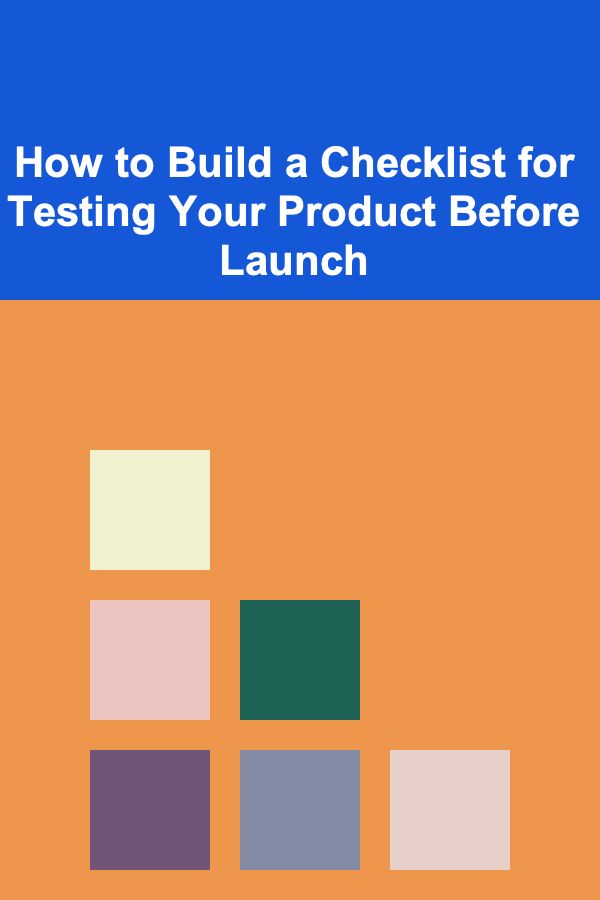
How to Build a Checklist for Testing Your Product Before Launch
ebook include PDF & Audio bundle (Micro Guide)
$12.99$10.99
Limited Time Offer! Order within the next:

Launching a new product is an exciting yet daunting task for any entrepreneur. Whether you're starting a dropshipping business or introducing a new product line to your existing store, ensuring that your product is ready for the market is crucial. A successful product launch can set the tone for the entire brand's future, while a poorly executed one can harm your reputation and sales potential.
One of the most important steps in preparing for a product launch is thorough product testing. Testing helps identify potential flaws, ensure product quality, and fine-tune customer experience. But with so many aspects to consider, how can you make sure that your product is truly ready? That's where a comprehensive testing checklist comes into play.
In this actionable guide, we'll walk you through how to create a robust checklist for testing your product before launch, ensuring that you leave no stone unturned and set your business up for success.
Define Your Product's Core Functionality
The first step in your product testing checklist is to verify that your product does what it's supposed to do. This may seem obvious, but it's essential to test every single feature of your product to ensure it performs consistently and reliably.
Key Considerations:
- Functionality: Does the product perform its primary function as expected? For example, if you're selling a kitchen gadget, does it effectively perform the task it was designed for?
- Ease of Use: Is the product easy to use, and does it provide a seamless experience for the customer? Are there any barriers to using it correctly?
Actionable Step:
- Test Each Feature: Break down each feature of the product and test it separately. Document any malfunctions or inconsistencies, and address them before moving to the next step.
Tools:
- Use test scripts to systematically check each function and feature.
- Ask people unfamiliar with the product to test it and provide feedback on ease of use.
By thoroughly testing the functionality of your product, you ensure that customers will experience it as intended and have no issues with its core purpose.
Conduct Quality Assurance (QA) Testing
Quality assurance (QA) testing is essential to guarantee that your product is free from defects and meets your quality standards. QA testing is not just about checking if the product works, but ensuring that it is reliable, durable, and safe for use.
Key Considerations:
- Material Quality: Are the materials used in the product of high quality? Are they durable and suitable for the intended use?
- Build Quality: Does the product have any structural flaws, such as loose parts, cracks, or potential breakage points?
- Safety: Is the product safe for consumers to use, and does it meet industry safety standards (e.g., certifications, legal regulations)?
- Longevity: Can the product withstand regular usage over time without degradation?
Actionable Step:
- Run Stress Tests: If applicable, subject the product to intense or extended use to see how it holds up over time. For example, if you're selling a chair, test its ability to hold weight for extended periods.
- Third-Party Testing: Consider sending your product to a third-party laboratory for testing, especially if you're in an industry with strict safety standards (e.g., toys, electronics, or health products).
By running quality assurance tests, you'll ensure that your product is not only functional but also durable and safe for customers.
Evaluate Packaging and Presentation
Your product's packaging is more than just a container for the item; it's part of your brand experience. Poor packaging can damage the product, make it difficult to use, or even discourage customers from buying. Ensuring that your packaging is both functional and visually appealing is a critical part of product testing.
Key Considerations:
- Protection: Does the packaging adequately protect the product during shipping? Is the product secure and free from damage when it arrives at the customer's doorstep?
- Branding: Does the packaging reflect your brand identity? Is it visually appealing and aligned with your marketing message?
- Ease of Unboxing: Is the product easy to remove from the packaging without causing frustration or damage?
Actionable Step:
- Conduct Unboxing Tests: Have individuals unbox the product and provide feedback on the process. Is it easy to open? Does the packaging hold the product securely?
- Assess Visual Appeal: Ensure the design aligns with your brand's aesthetics and is likely to appeal to your target audience.
Proper packaging ensures that the product arrives in perfect condition while also enhancing the customer's first impression of your brand.
Test User Experience (UX) and Customer Journey
Whether your product is physical or digital, the user experience is crucial. Testing the customer journey---how customers interact with the product, as well as the buying and unboxing process---helps ensure a smooth and pleasant overall experience.
Key Considerations:
- Ease of Use: Is the product easy for customers to operate right out of the box? Are there clear instructions, and do customers understand how to use it?
- Customer Support: If there are any issues or questions, is your customer support system in place and ready to assist?
- Instructions and Documentation: Are there any manuals, guides, or videos available to help customers understand how to use the product?
Actionable Step:
- Conduct User Testing: Bring in people who have never used the product before and observe their interactions with it. Are they able to use it intuitively? Is there confusion at any stage?
- Gather Feedback: After the test, ask participants for their feedback on what could be improved, both in terms of functionality and the overall experience.
A smooth and intuitive user experience plays a key role in customer satisfaction and product success, so take the time to thoroughly test this aspect.
Validate Product Performance Under Real Conditions
Testing your product under real-world conditions is essential to determine its effectiveness. This is particularly important for products that are used in specific environments or for specialized tasks.
Key Considerations:
- Real-Life Usage: Does the product perform as expected when used in real-life scenarios? Consider how the product will be used by your typical customers and test it in those conditions.
- Environmental Factors: If applicable, test the product in different environmental conditions, such as heat, cold, humidity, or various surfaces, to ensure it performs well across a range of situations.
Actionable Step:
- Simulate Real Conditions: If you're selling a product that will be used outdoors, for example, test it in various weather conditions or during extended use. If it's an electronic device, try it under heavy usage or across different operating systems.
Testing in real-world conditions helps ensure that the product can meet the challenges your customers will face once it's in their hands.
Test Pricing, Positioning, and Market Fit
Before launching, it's also essential to test whether your product aligns with your target market's expectations in terms of pricing and positioning. Even if the product is great, it won't succeed if the market doesn't see the value or is unwilling to pay the asking price.
Key Considerations:
- Competitive Pricing: Does the product's price point align with market expectations? Is it competitive with similar products, or does it offer unique value at a premium price?
- Market Positioning: Is the product positioned well in the market? Does it stand out from competitors in a meaningful way?
- Customer Feedback: Does the market believe your product offers enough value for the price?
Actionable Step:
- Conduct Market Research: Survey potential customers to gauge their reactions to the price and product positioning. Offer prototypes or samples to a select group and gather their feedback.
- Test Price Sensitivity: Consider A/B testing different price points in small test markets to see how consumers react.
By validating your pricing and positioning, you'll ensure that your product is not only functional but also appealing to the right audience at the right price.
Track and Analyze Results
Once you've completed the initial round of testing, it's time to analyze your results. Make sure to review all the feedback and identify any recurring issues or areas for improvement. Keep track of key performance metrics and adjust your product accordingly.
Actionable Step:
- Collect Data and Insights: Gather all feedback and test results in one place. Identify patterns and issues that need addressing before launch.
- Iterate and Improve: Use the insights gained from testing to make necessary improvements. Whether it's a design tweak, a functionality change, or packaging adjustments, take the time to refine the product.
Tools:
- Use feedback collection tools, like surveys and focus groups, to ensure you have all the necessary data to make informed decisions.
- Leverage analytics tools to track product performance post-launch and make adjustments as needed.
Conclusion
A comprehensive product testing checklist is critical for ensuring that your product meets customer expectations and is fully prepared for launch. By carefully testing your product's functionality, quality, packaging, user experience, and market fit, you can avoid costly mistakes and ensure that your launch is a success. Remember, thorough testing not only helps prevent issues but also boosts your credibility and builds trust with your customers, paving the way for long-term success.
Reading More From Our Other Websites
- [Organization Tip 101] How to Transition Your Wardrobe from Summer to Fall
- [Home Budget Decorating 101] How to Get a High-End Look for Less: Mastering Thrifting and DIYs for Decorating on a Shoestring Budget
- [Toy Making Tip 101] From Fun to Function: Crafting Eco‑Friendly Toys for a Sustainable Future
- [Personal Finance Management 101] How to Adjust Your Financial Planning for Different Life Stages to Reflect Economic Changes
- [Home Budget Decorating 101] How to Decorate a Small Apartment on a Budget
- [Beachcombing Tip 101] Essential Tools and Techniques for Spotting Agates on the Trail
- [Personal Investment 101] How to Start Trading Options Safely for Higher Returns
- [Rock Climbing Tip 101] Safety First: Common Mistakes New Climbers Should Avoid
- [Home Budget Decorating 101] How to Style Shelves with Inexpensive Decor Items
- [Trail Running Tip 101] Gear Guide: Must-Have Shoes, Packs, and Gadgets for Mountain Trail Running

How to Create a Checklist for Managing Event Transportation and Parking
Read More
How to Design a Practical Storage Room for All Your Extras
Read More
How to Organize a Family Talent Show in Your Living Room
Read More
How to Secure Your Home from Home Invasion
Read More
Top Deep Learning Projects That Can Earn You Money
Read More
How to Craft a Realistic New Year's Resolution To-Do List
Read MoreOther Products

How to Create a Checklist for Managing Event Transportation and Parking
Read More
How to Design a Practical Storage Room for All Your Extras
Read More
How to Organize a Family Talent Show in Your Living Room
Read More
How to Secure Your Home from Home Invasion
Read More
Top Deep Learning Projects That Can Earn You Money
Read More